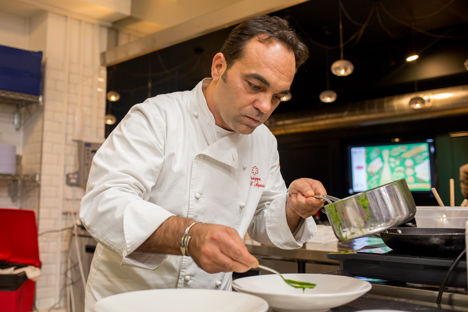
Cook school confidential: cooking with pasta
We invited Michelin-starred Italian chef Giuseppe D’Aquino over to the UK to learn the secrets of cooking pasta perfectly.
Cook school confidential: cooking with pasta
We invited Michelin-starred Italian chef Giuseppe D’Aquino over to the UK to learn the secrets of cooking pasta perfectly.
In a relatively short space of time, pasta has gone from an exotic dish served by ambitious British cooks in the 1960s to a staple in nearly every single household. It’s a relatively quick thing to cook that’s simple to prepare and can be paired with all sorts of delicious sauces. However, some things were lost in translation during the journey pasta made to our shores. Back in Italy, certain pasta shapes go with certain sauces and dried pasta isn’t just boiled in salted water until soft – it’s cooked in quite a specific way.
That’s why we invited Giuseppe D’Aquino, head chef of the Michelin-starred Ristorante Oseleta in the hills of Lake Garda, to come and show us how it’s done. His cooking draws inspiration from all the different regions of Italy, and he knows how to get the best out of something as simple as dried pasta. It was at the Underground Cookery School in London, in association with Barilla, that he shared his knowledge and expertise with a group of bloggers and journalists.
Giuseppe began by preparing something out of the ordinary for everyone at the event to try – Fusilli with parsley extract, clam cream and sea urchin. The vivid green sauce was intense, fresh and salty, but what was surprising was how al dente the pasta was. While we’re all familiar with this term and know pasta is ready when it still has a little bite to it and doesn’t go fully soft, this was taken off the boil a minute or two before that – something Giuseppe said was very important so as to retain the texture of the pasta.
Once everyone had finished their tasters of this dish, Giuseppe moved straight on to the next one. This was the plate of food that he said won him the Michelin star, and everyone in attendance was going to cook it themselves. The simplicity of it was surprising, but the techniques Giuseppe used offered some invaluable knowledge. Spaghetti with Piennolo tomatoes and burrata was a recipe the chef created because he knew that when people visited Italy they wanted to eat things like pizza and pasta with tomato sauce – something the country is famous for. Giuseppe had brought the tomatoes and burrata with him on the plane, proclaiming they were the best in the world (which, after tasting them, everyone was inclined to agree with).
The first thing Giuseppe taught the class was that there were two ways to cook a tomato sauce – either very, very fast to retain freshness or very, very slowly to bring out the deeper, sweeter notes of the fruit. For this recipe, the tomatoes were cooked in hot olive oil with garlic and basil for no more than a minute, before being taken off the heat. The second lesson came when he added a ladle of pasta cooking water and some half-cooked spaghetti to the pan, and told everyone to continue cooking the pasta and sauce together slowly, while vigorously stirring everything together. This allows the starchy water to emulsify the sauce, while at the same time the pasta finishes cooking and absorbs some of the sauce-water mixture back up. Once finished, the sauce and spaghetti were as one, and after a clever trick where a fork twirls up spaghetti into a ladle so it can be presented nicely, we were ready to plate up.
After that, all it took was some torn burrata, grated lemon zest and a few basil leaves and the dish was ready. It was clear why this was Giuseppe’s signature dish; the short ingredient list and simple process creating something way more than the sum of its parts, thanks in part to the incredible Piennolo tomatoes. The chef reiterated that this was what won him a Michelin star, and it was clear that everyone in the room agreed it was certainly worthy of the award.


